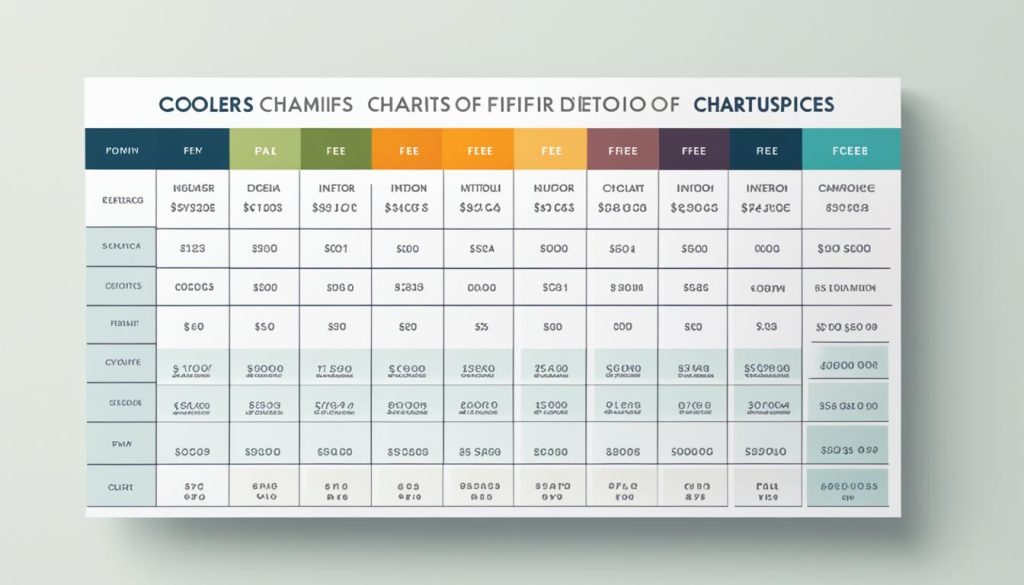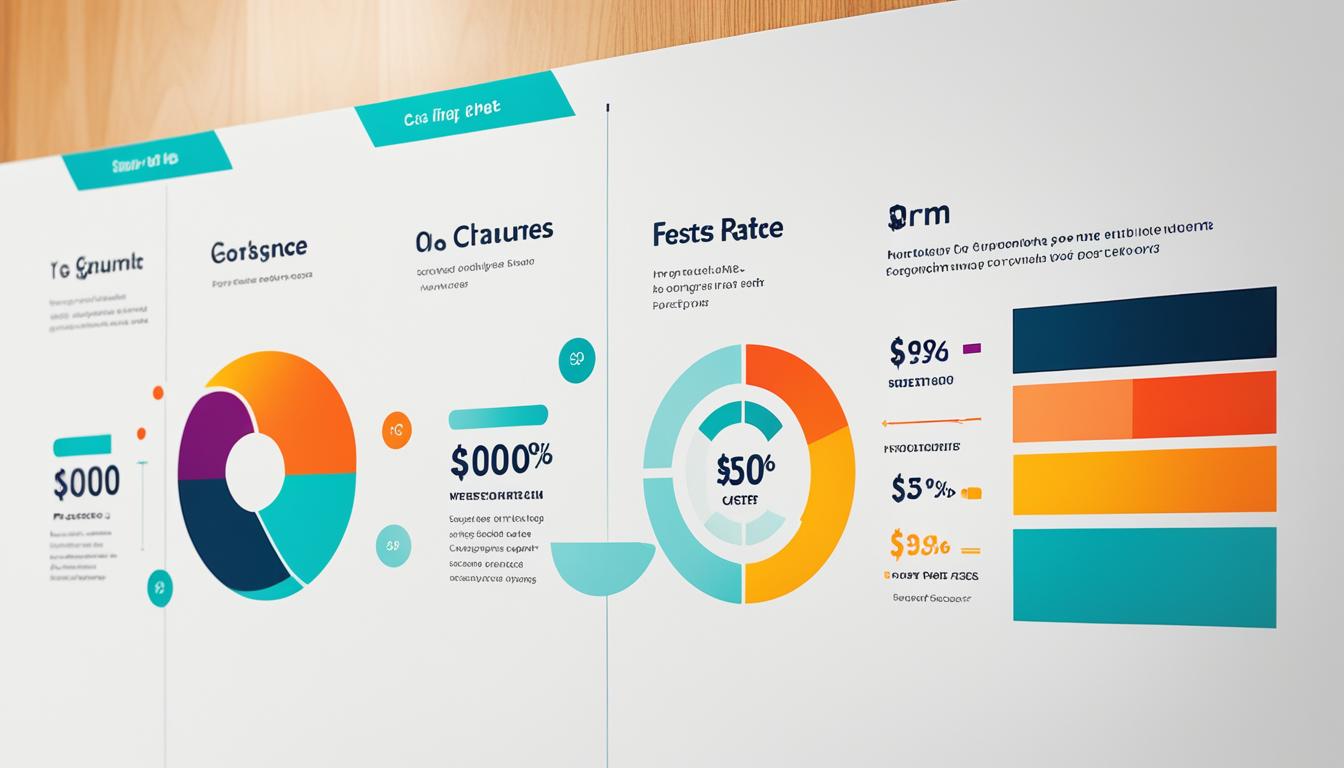Did you know that the pricing structure for interior design services can vary widely among professionals? From phased fees to percentage-based charges, interior designers have different methods of charging for their services. Understanding these fee structures is essential for clients looking to hire an interior designer for their project.
Key Takeaways:
- Interior designers use different fee structures to charge for their services.
- Factors such as experience, reputation, and project complexity can influence the fees.
- Hourly rates and flat fees are common fee structures used by interior designers.
- Each fee structure has its own pros and cons.
- A recommended fee structure is a flat rate design fee with an hourly rate for project management.
- Interior designers may charge procurement fees and have access to trade discounts.
Factors Influencing Interior Design Fees
When it comes to hiring an interior designer, there are several factors that can influence the fees charged. Understanding these factors can help you budget and plan for your interior design project effectively.
The cost of hiring an interior designer can vary based on a few key elements. Firstly, the designer’s level of experience and expertise can play a role in determining their fees. A more established and reputable designer may charge higher fees due to their track record of successful projects and satisfied clients.
Another factor to consider is the designer’s location. Fees can vary depending on the city or region you are in. Designers in larger urban centers or areas with a high cost of living may charge more due to higher operating expenses.
The scope and complexity of your project can also influence the fees charged by interior designers. Larger-scale projects that require more time and resources may come with higher fees compared to smaller, more straightforward projects.
It’s important to note that interior design consultation rates can also vary depending on the designer and the specific services provided. Some designers may charge a flat fee for their initial consultation, while others may offer a complementary consultation as part of their services.
Considering these factors and discussing them openly with your interior designer will help you gain a better understanding of the expected costs for your project.
Factors Influencing Interior Design Fees
| Factors | Explanation |
|---|---|
| Experience and Reputation | Experienced and well-known designers may charge higher fees due to their track record of success and client satisfaction. |
| Location | Designers in high-cost areas or urban centers may charge more to cover their operational expenses. |
| Scope and Complexity of the Project | Larger-scale projects that require more time and resources can lead to higher design fees. |
| Services Provided | Consultation rates can vary depending on the designer’s offerings and whether it is included in the overall fee or charged separately. |
Different Fee Structures for Interior Design Services
When it comes to pricing, interior designers offer various fee structures to cater to their clients’ needs. Two common fee structures are the hourly rate and the flat fee. Let’s take a closer look at each of these structures.
Hourly Rate
Some interior designers charge an hourly rate, where clients are billed based on the time spent on the project. This fee structure is particularly beneficial for smaller scopes of work or when clients want more control over their expenses. With an hourly rate, clients can have a clear understanding of the actual time and effort invested in their project.
Flat Fee
In contrast, other interior designers opt for a flat fee structure, where clients pay a set amount for the entire project. This fee structure provides transparency and clarity on the cost of the design services from the outset. Clients can have peace of mind knowing the total cost upfront and can plan their budget accordingly.
Both fee structures have their advantages and can be appropriate depending on the project and client’s preferences. The best approach is to discuss the options with your interior designer and determine which fee structure aligns with your specific needs and budget.
| Fee Structure | Advantages | Disadvantages |
|---|---|---|
| Hourly Rate |
|
|
| Flat Fee |
|
|
Pros and Cons of Different Fee Structures
When it comes to interior design fees, there are different fee structures to consider. Understanding the pros and cons of each can help you make an informed decision based on your preferences and project requirements.
Fixed Fee
A fixed fee structure provides clarity on the cost upfront. This means you’ll know exactly how much you’ll be paying for the design services from the start. It eliminates any surprises or uncertainty regarding the final bill.
However, a fixed fee may not account for unexpected changes or additional work that may arise during the project. If there are any modifications or additional design elements requested, there may be additional charges that were not initially included in the fixed fee.
Hourly Fee
An hourly fee structure allows for more flexibility and transparency. Clients are billed based on the time spent on the project, providing a more accurate reflection of the designer’s efforts.
However, some clients may feel pressured by the ticking clock and may be concerned about the total cost accumulating as the hours go by. It’s important to discuss and establish clear expectations and budget parameters with your designer to address any concerns related to hourly billing.
Percentage of Spend
Another fee structure that some designers offer is a percentage of spend. This means that the designer’s fee is calculated as a percentage of the total project budget, including purchases made for furniture, fixtures, and other elements.
This fee structure aligns the designer’s fee with the project budget, and it can serve as an incentive for the designer to find cost-effective solutions. However, it also raises questions about the designer’s intentions, as there may be concerns about whether the designer is motivated to maximize purchases to increase their fee.
Consider your preferences, project requirements, and the level of transparency you desire when choosing a fee structure for your interior design project. Understanding the pros and cons of each can help you make an informed decision that aligns with your needs.
| Fee Structure | Pros | Cons |
|---|---|---|
| Fixed Fee | Clarity on cost upfront | Does not account for unexpected changes or additional work |
| Hourly Fee | Flexibility and transparency in billing | Clients may feel pressure from accumulating costs |
| Percentage of Spend | Aligns designer’s fee with project budget | Raises questions about designer’s intentions |

Recommended Fee Structure for Interior Design Services
When it comes to interior design services, there are various fee structures to consider. However, some interior designers recommend a specific fee structure that combines both transparency and flexibility. This recommended fee structure involves a flat rate design fee paired with an hourly rate for project management.
By opting for a flat rate design fee, clients can have a better understanding of the upfront costs associated with the design services. This provides transparency and eliminates any uncertainties regarding the overall design fee. It allows clients to plan their budget effectively and ensures that there are no surprises along the way.
Additionally, incorporating an hourly rate for project management offers flexibility when it comes to billing for the time spent on managing the project. Project management typically involves coordinating with contractors, overseeing timelines, and ensuring that everything runs smoothly. By billing for project management separately at an hourly rate, interior designers can provide a clear breakdown of costs and ensure that clients are only paying for the time invested in managing their project.
Effective communication between the client and designer is crucial to ensure that the recommended fee structure aligns with the client’s preferences and project requirements. It allows for transparency and allows both parties to be on the same page when it comes to the design process and associated fees. This ensures a smooth and successful design experience for all involved.

Choosing the right fee structure is an important decision when hiring an interior designer. The recommended fee structure of a flat rate design fee with an hourly rate for project management offers transparency, flexibility, and clear cost breakdowns. It provides clients with peace of mind and allows them to effectively plan their budget. By working closely with your interior designer and having open communication, you can ensure a successful design project with no fee surprises along the way.
Procurement and Trade Discounts
When hiring an interior designer, it is important to consider not only the design fees but also any additional costs that may be involved. One such cost is the procurement fees for purchasing furniture, fixtures, and equipment (FF&E) on behalf of the client. These procurement fees can be a percentage of the cost of the goods, enabling the designer to cover their time and effort spent in sourcing and managing these items.
In addition to procurement fees, interior designers may also have access to trade discounts, which can be passed on to the client. Trade discounts are special pricing arrangements with manufacturers, suppliers, and vendors in the interior design industry. These discounts can vary depending on the designer and the products being purchased. By leveraging their industry connections, designers can often secure significant savings on items such as furniture, lighting, and decor pieces.
It is important for clients to have a clear understanding of how these trade discounts will be applied to their project. Some designers may choose to pass on the full discount to the client, while others may retain a portion of the savings. Make sure to have open communication with your designer regarding this matter so that you are aware of the potential cost savings and any fees associated with procurement.
By considering both the procurement fees and trade discounts, clients can make informed decisions about their interior design project’s overall budget. Understanding these additional costs and potential savings can help ensure a transparent and mutually beneficial working relationship between the client and the interior designer.
